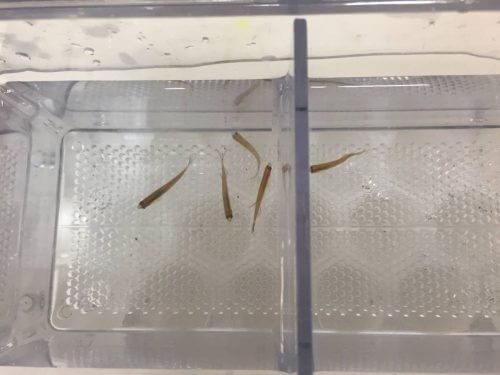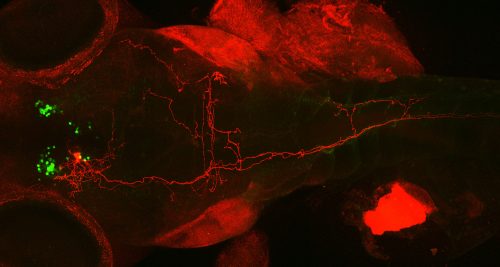What are the effects of the Otp protein on social and anxiety behavior in a zebrafish model? Scientists have discovered that when there is only one version of the two genes responsible for producing the protein in fish, changes in their social behavior and anxiety reactions are caused. The researchers showed that Otp controls the development of the nerve cells that are responsible for the production of the hormone oxytocin, and these act as a "switch" that maintains a balance between the feeling of stress and sociability.

Zebrafish are social animals. Both in nature and in laboratory conditions they swim together in groups. But in some cases, changes are evident in the natural tendency of the fish to be very sociable. What causes this? What are the brain mechanisms underlying these behavioral changes, and what is the connection to social behavior in humans? These questions were at the center of a new study, which was carried out in the laboratory of Prof. Gil Lebkowitz, from the Department of Molecular Biology of the Cell. The study follows the effects of the Otp protein on nerve cells in the brains of zebrafish, effects that translate into patterns of social behavior. The researchers identified a new group of nerve cells that produce two hormones at the same time, and it is possible that their action helps maintain a balance between the feeling of stress and sociability.
The Otp protein is a transcription factor that is involved in the development of certain nerve cells in the hypothalamus region of the brain. This protein is essential for the survival of mammals, therefore, those lacking the gene encoding Otp do not survive after birth. Unlike mammals, the zebrafish carries two separate genes, which are responsible for the production of two almost identical proteins, Otpa and Otpb. This means that a mutation in any of these genes has only a minor effect on the development of the fish, and they survive to adulthood. This phenomenon created for the research group led by Prof. Lebkowitz a unique opportunity to study the physiological effects that the Otp protein has on the adult animal, in the area of social behavior and anxiety. They discovered that, although the effects of the protein are seemingly minor, it controls systems whose defects are associated with neurodevelopmental disorders such as autism.
The research was led by the research student Einav Wirtzer, and Dr. Zhanna Balchman and Dr. Natalia Borodovsky participated in it alongside her - all from Prof. Lebkowitz's research group. Other participants are Dr. Michael Tzuri from the Department of Veterinary Resources; Prof. Roy Oliveira from the ISPA University Institute and the Gulbenkian Institute in Lisbon, Portugal; and the post-doctoral researcher, Dr. Rita Nunez, who recently returned to Portugal but continues to collaborate with Prof. Lebkowitz's laboratory.
The research findings revealed that when all copies of the Otp genes are missing, the zebrafish do not survive. But even when only one version of it is missing, this has an effect on the social behavior of the fish, and on their response to anxiety. "The fish, which are usually social creatures, suddenly exhibit less social behavior, and their anxiety response is also not normal," explains Prof. Lebkowitz. "A normal fish will swim towards a 'social area', meaning in the direction of the fish swimming in an adjacent aquarium. But the mutant fish, which lacks one of the Otp genes, is much less inclined to swim near the social area." The two types of fish also differ in their response to a foreign environment. While fish with normal Otp copies will first swim around the center of the aquarium, and as they adapt to their environment will begin to move towards the sides, the mutant fish do not exhibit any such normal "anxious" behavior.

The researchers showed that Otp controls the development of the nerve cells that are responsible for the production of the hormone oxytocin. This hormone is involved in creating social relationships and trust, as well as in sexual behavior. "Oxytocin is often called the 'love hormone', due to its social effects, but this name does not reflect its broad activity," says Prof. Lebkowitz. "Oxytocin has various roles in the body, including lowering the stress level, regulating appetite and metabolism."
The scientists located an unknown group of cells in the hypothalamus, which produces abnormal levels of oxytocin in fish carrying a mutation in the gene encoding the Otpa protein. When they used a laser, aimed with maximum precision to destroy only these cells (which is possible due to the transparent skin of the fish embryos), a less social behavior emerged in these fish. "That's how we understood what the role of the nerve cells is, and also that the existence of only one version of the gene impairs the functioning of the fish," explains Prof. Lebkowitz.
It was later discovered that these cells are involved not only in the production of oxytocin, but also in the production of another hormone, CRH, which is associated, among other things, with the body's response to anxiety and stress. Prof. Lebkowitz explains that these nerve cells, which control the production of the two hormones, can be the "switch" that switches between the "social" state and the "anxious" state. "Another possibility is that the nerve cells are able to produce several different hormone levels at the same time, and it is their relative activity that regulates both situations," says Prof. Lebkowitz.

In the next step Wirzer developed a genetic method for labeling individual nerve cells with a red fluorescent protein, against the background of all the nerve cells in the fish brain. This method allows tracking of each of the discovered cells - cells that are in a dense network of nerve cell extensions that produce oxytocin (which were labeled with a green fluorescent protein). After repeating the experiment with several dozens of neurons, a series of images was obtained, in each of which one neuron, painted red, is inside a green network of cells. Thus it turned out that the cells discovered in the hypothalamus have a structure of branched extensions (dendritic trees), which send a single, long extension (axon) to the brainstem and spinal cord. This structure, says Prof. Lebkowitz, is typical of nerve cells that receive sensory information and turn it into a signal that is transmitted to the body. Some of the axons extended to the ends of the fish's spines, suggesting that the sensory information may be translated into the impulse expressed in swimming.
"The anatomical structure and genetic composition of nerve cells that produce oxytocin in fish are remarkably similar to those of humans," says Prof. Lebkowitz. "The fact that this system has remained in a similar configuration for millions of years, and in thousands of species, is evidence of its evolutionary importance. Most likely, humans have the same nerve cells that function as 'switches' in fish. But in the human brain, especially in the hypothalamus, which controls many functions, it will be difficult to locate them and examine their mode of operation. In zebrafish we are beginning to understand how the Otp protein is involved in the roles of sociability and anxiety. This discovery could help us understand how neurodevelopmental diseases develop, and how they cause behavioral problems in adulthood."
#Science_Numbers
Zebrafish embryos have 30-40 neurons that produce oxytocin, compared to several thousand in mammals.
